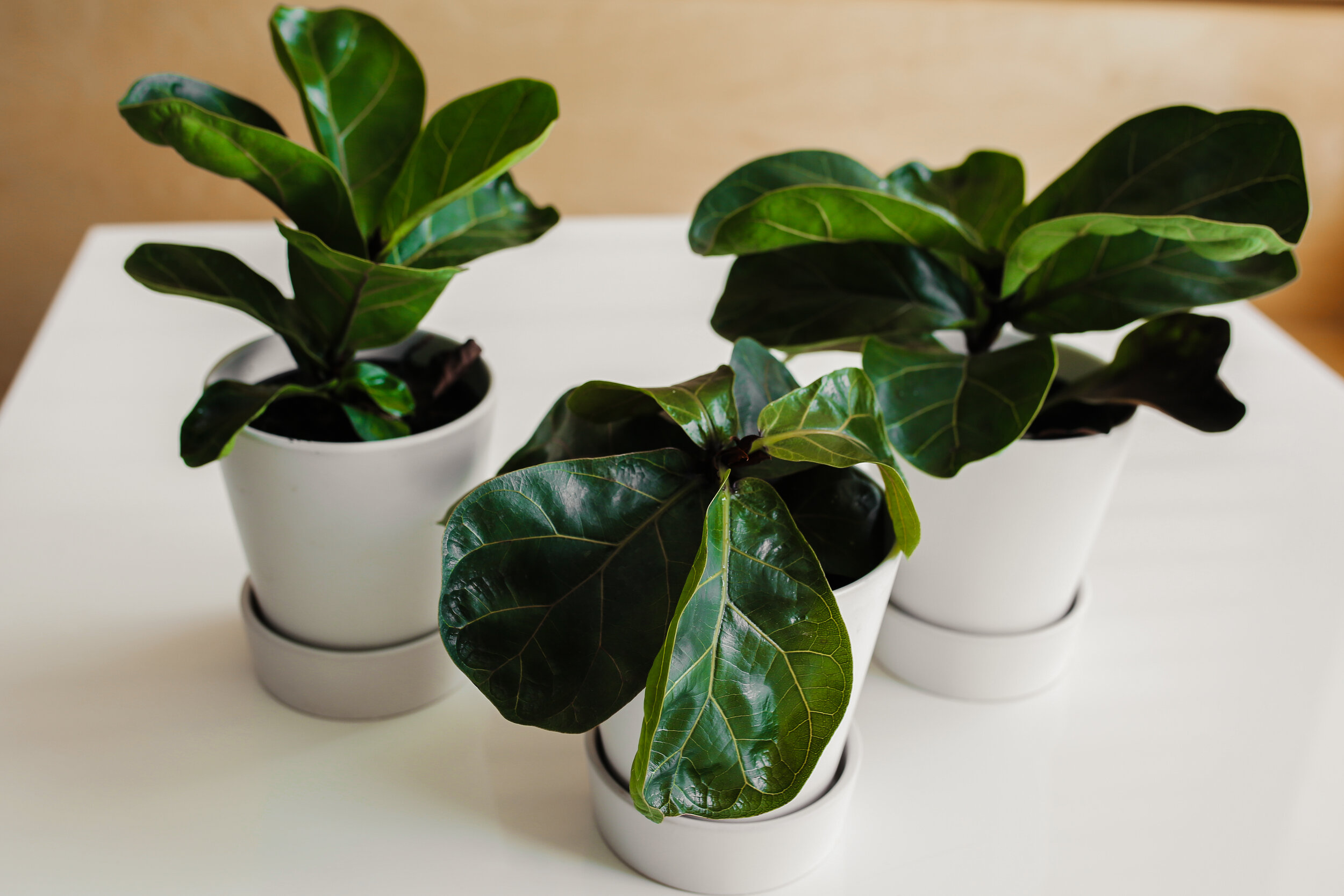What's Wrong With My Fiddle Leaf Fig? How to Care for Common Fiddle Leaf Fig Problems
What’s Wrong with My Fiddle Leaf Fig?
Known for its gorgeous, broad, and shiny deep green leaves, the Fiddle Leaf Fig tree is among the most popular houseplants today. However, if you have one of them in your plant collection, you may also know that it has a bit of a reputation for being high maintenance, dramatic, and quite finicky. In this guide, we’ll discuss why your Fiddle Leaf Fig may be showing you some attitude and how to troubleshoot common problems such as watering stress, improper temperature or light exposure, and fungal infections.
Water Problems
Overwatering Symptoms: The signs of overwatering are easy to spot. Brown spots or brown shaded areas in the middle of the leaves along with around the edges, yellowing leaves, and leaf drop (lower leaves often dropping first).
Overwatering is one of the most common Fiddle Leaf Fig problems. If your plant receives too much water, it can lead to a fungal infection, commonly known as root rot. If root rot is the culprit, you’ll probably see spots and leaf drop on older leaves first.
How to Fix It: To treat root rot, allow your plant to dry out completely before you water it again, and make sure it has plenty of indirect sunlight. You can trim brown edges and spots off the leaves with clean shears as well as remove any brown and mushy roots that may have formed.
Under watering Symptoms: Just like overwatering, the symptoms of a dried-out plant are easy to spot as well. Brown spots start on the edges of its leaves, curling leaves from the edges inward, and leaf drop (can affect all leaves on the plant, not just the lower leaves).
Under watered Fiddle Leaf Figs will also have dry, hard soil that recedes and shrinks away from the edge of the pot.
How to Fix It: Stick to a consistent watering schedule. Fiddle Leaf Figs will typically need to be watered once a week or when the top inch of soil is dry to the touch. To help combat dry air, try running a humidifier nearby or misting the leaves with water every 1-3 days to increase the humidity in the surrounding air. It’s also beneficial to make sure you don’t place your plant too close to an air vent, which can dry it out in all seasons.
Try to stick to your watering schedule to help ensure that you are not overwatering or underwatering your plant. It is important to make sure your plant’s pot has proper drainage or your watering schedule could get thrown off if it is not draining properly. Temperature and Light Problems
Temperature and Light Problems
Sunburn Symptoms: We all love sunshine, but sometimes your houseplant could be getting too much. Light brown or bleached-looking spots near the tops of the leaves are an indicator of that or if the spots on the leaves appear to have a red or yellow coloring.
Fiddle Leaf Figs like bright, indirect light and should be kept in a room that has plenty of sunshine, but not directly in the sun or they will overheat.
How to Fix It: Prune away any damaged leaves with clean shears and move your Fiddle Leaf to a more protected location where it receives bright, but not direct sunlight.
Cold Exposure Symptoms: Dark, droopy, and browning leaves leading to leaf drop.
One of the Fiddle Leaf’s least favorite things is a cold breeze. Cold draft exposure is most common from repeatedly opening doors and sitting near cold windows in the winter or when the A/C kicks on in the summer. Fiddle Leaf Figs are native to tropical regions, so it is important to keep their ideal warm and humid temperature in mind.
How to Fix It: Place your Fiddle Leaf Fig in a spot that is protected from any cool drafts and remove any brown leaves with clean shears.
Temperature Fluctuation Symptoms: Dry and cracked leaves
During the changing seasons, our vents and heaters send out air to regulate your home’s temperature. This air is often very dry and can cause your Fiddle’s leaves to crack!
How to Fix It: Dry air means low humidity. To help boost the humidity in your plant’s surrounding air, try placing a humidifier nearby. Regularly misting its leaves with water every 1-3 days can also help increase humidity in its environment.
Light and Temperature Tips
Native to tropical climates, Fiddle Leaf Figs do best in temperatures between 60 and 75 degrees Fahrenheit. They will typically be happy in your home’s average room temperature. They also enjoy lots of bright, indirect sunlight throughout the day. If they do not receive enough light, they will tell you by shedding their leaves.
What Your Fiddle Leaves are Telling You
Fiddle Leaf Figs are great at communicating when there is a problem. These are the most common signs that your Fiddle Leaf is crying for help:
Brown Spots- Typically mean there is some watering stress occurring. Overwatering or poor drainage can cause spots to appear and can lead to fungal infections such as root rot.
Yellowing Leaves- There are a few culprits of this sign. Yellowing leaves are usually from lack of sunlight, lack of nutrients, over, as well as too much or too little water. If your plant has yellow leaves and you’re not sure why, check out our more in-depth advice on how to spot and treat yellowing leaves.
Leaf Drop- This symptom can occur in many situations, but the most common for Fiddle Leaf Figs are from fluctuation in temperature and light and an inconsistent watering routine. To learn more about leaf drop issues with other houseplants check out our blog on how to combat leaf drop.
How to Care for the Fiddle Leaf Fig
Don’t panic if you’ve been considering adding a Fiddle Leaf to your collection! Although they may have a rough reputation, they can thrive when given proper care along with a consistent watering routine. They are happiest when placed in a location that receives bright, indirect sunlight, stays free of any cool drafts, and is watered regularly about once a week. Check out our blog for more information on how to care for your Fiddle Leaf Fig. Before you know it, you’ll be an expert on dealing with Fiddle Leaf Fig tantrums! Plus, you can always message us on Instagram for a quick response!



